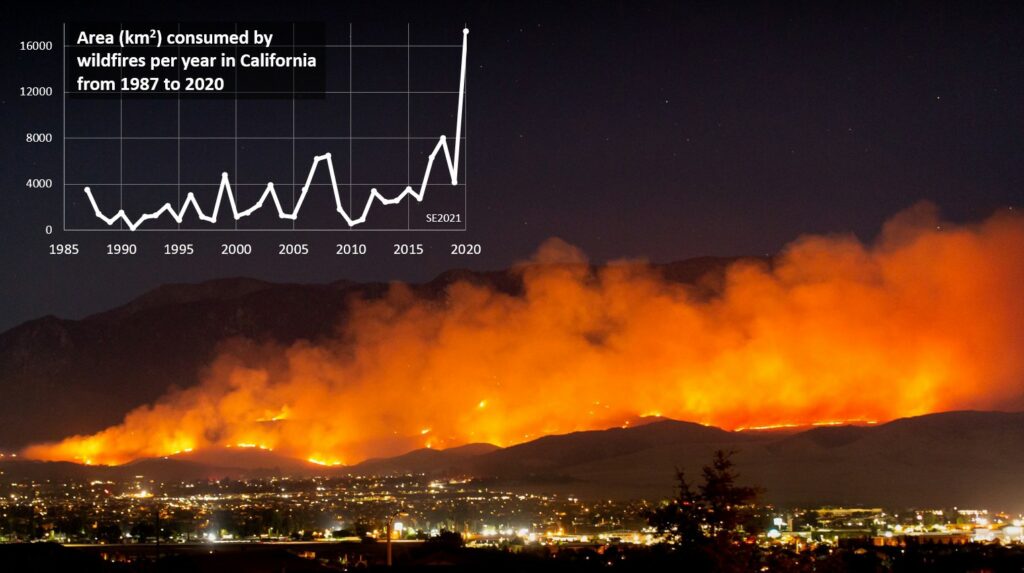15: Geological Implications of Climate Change
- Page ID
- 25495
\( \newcommand{\vecs}[1]{\overset { \scriptstyle \rightharpoonup} {\mathbf{#1}} } \)
\( \newcommand{\vecd}[1]{\overset{-\!-\!\rightharpoonup}{\vphantom{a}\smash {#1}}} \)
\( \newcommand{\dsum}{\displaystyle\sum\limits} \)
\( \newcommand{\dint}{\displaystyle\int\limits} \)
\( \newcommand{\dlim}{\displaystyle\lim\limits} \)
\( \newcommand{\id}{\mathrm{id}}\) \( \newcommand{\Span}{\mathrm{span}}\)
( \newcommand{\kernel}{\mathrm{null}\,}\) \( \newcommand{\range}{\mathrm{range}\,}\)
\( \newcommand{\RealPart}{\mathrm{Re}}\) \( \newcommand{\ImaginaryPart}{\mathrm{Im}}\)
\( \newcommand{\Argument}{\mathrm{Arg}}\) \( \newcommand{\norm}[1]{\| #1 \|}\)
\( \newcommand{\inner}[2]{\langle #1, #2 \rangle}\)
\( \newcommand{\Span}{\mathrm{span}}\)
\( \newcommand{\id}{\mathrm{id}}\)
\( \newcommand{\Span}{\mathrm{span}}\)
\( \newcommand{\kernel}{\mathrm{null}\,}\)
\( \newcommand{\range}{\mathrm{range}\,}\)
\( \newcommand{\RealPart}{\mathrm{Re}}\)
\( \newcommand{\ImaginaryPart}{\mathrm{Im}}\)
\( \newcommand{\Argument}{\mathrm{Arg}}\)
\( \newcommand{\norm}[1]{\| #1 \|}\)
\( \newcommand{\inner}[2]{\langle #1, #2 \rangle}\)
\( \newcommand{\Span}{\mathrm{span}}\) \( \newcommand{\AA}{\unicode[.8,0]{x212B}}\)
\( \newcommand{\vectorA}[1]{\vec{#1}} % arrow\)
\( \newcommand{\vectorAt}[1]{\vec{\text{#1}}} % arrow\)
\( \newcommand{\vectorB}[1]{\overset { \scriptstyle \rightharpoonup} {\mathbf{#1}} } \)
\( \newcommand{\vectorC}[1]{\textbf{#1}} \)
\( \newcommand{\vectorD}[1]{\overrightarrow{#1}} \)
\( \newcommand{\vectorDt}[1]{\overrightarrow{\text{#1}}} \)
\( \newcommand{\vectE}[1]{\overset{-\!-\!\rightharpoonup}{\vphantom{a}\smash{\mathbf {#1}}}} \)
\( \newcommand{\vecs}[1]{\overset { \scriptstyle \rightharpoonup} {\mathbf{#1}} } \)
\(\newcommand{\longvect}{\overrightarrow}\)
\( \newcommand{\vecd}[1]{\overset{-\!-\!\rightharpoonup}{\vphantom{a}\smash {#1}}} \)
\(\newcommand{\avec}{\mathbf a}\) \(\newcommand{\bvec}{\mathbf b}\) \(\newcommand{\cvec}{\mathbf c}\) \(\newcommand{\dvec}{\mathbf d}\) \(\newcommand{\dtil}{\widetilde{\mathbf d}}\) \(\newcommand{\evec}{\mathbf e}\) \(\newcommand{\fvec}{\mathbf f}\) \(\newcommand{\nvec}{\mathbf n}\) \(\newcommand{\pvec}{\mathbf p}\) \(\newcommand{\qvec}{\mathbf q}\) \(\newcommand{\svec}{\mathbf s}\) \(\newcommand{\tvec}{\mathbf t}\) \(\newcommand{\uvec}{\mathbf u}\) \(\newcommand{\vvec}{\mathbf v}\) \(\newcommand{\wvec}{\mathbf w}\) \(\newcommand{\xvec}{\mathbf x}\) \(\newcommand{\yvec}{\mathbf y}\) \(\newcommand{\zvec}{\mathbf z}\) \(\newcommand{\rvec}{\mathbf r}\) \(\newcommand{\mvec}{\mathbf m}\) \(\newcommand{\zerovec}{\mathbf 0}\) \(\newcommand{\onevec}{\mathbf 1}\) \(\newcommand{\real}{\mathbb R}\) \(\newcommand{\twovec}[2]{\left[\begin{array}{r}#1 \\ #2 \end{array}\right]}\) \(\newcommand{\ctwovec}[2]{\left[\begin{array}{c}#1 \\ #2 \end{array}\right]}\) \(\newcommand{\threevec}[3]{\left[\begin{array}{r}#1 \\ #2 \\ #3 \end{array}\right]}\) \(\newcommand{\cthreevec}[3]{\left[\begin{array}{c}#1 \\ #2 \\ #3 \end{array}\right]}\) \(\newcommand{\fourvec}[4]{\left[\begin{array}{r}#1 \\ #2 \\ #3 \\ #4 \end{array}\right]}\) \(\newcommand{\cfourvec}[4]{\left[\begin{array}{c}#1 \\ #2 \\ #3 \\ #4 \end{array}\right]}\) \(\newcommand{\fivevec}[5]{\left[\begin{array}{r}#1 \\ #2 \\ #3 \\ #4 \\ #5 \\ \end{array}\right]}\) \(\newcommand{\cfivevec}[5]{\left[\begin{array}{c}#1 \\ #2 \\ #3 \\ #4 \\ #5 \\ \end{array}\right]}\) \(\newcommand{\mattwo}[4]{\left[\begin{array}{rr}#1 \amp #2 \\ #3 \amp #4 \\ \end{array}\right]}\) \(\newcommand{\laspan}[1]{\text{Span}\{#1\}}\) \(\newcommand{\bcal}{\cal B}\) \(\newcommand{\ccal}{\cal C}\) \(\newcommand{\scal}{\cal S}\) \(\newcommand{\wcal}{\cal W}\) \(\newcommand{\ecal}{\cal E}\) \(\newcommand{\coords}[2]{\left\{#1\right\}_{#2}}\) \(\newcommand{\gray}[1]{\color{gray}{#1}}\) \(\newcommand{\lgray}[1]{\color{lightgray}{#1}}\) \(\newcommand{\rank}{\operatorname{rank}}\) \(\newcommand{\row}{\text{Row}}\) \(\newcommand{\col}{\text{Col}}\) \(\renewcommand{\row}{\text{Row}}\) \(\newcommand{\nul}{\text{Nul}}\) \(\newcommand{\var}{\text{Var}}\) \(\newcommand{\corr}{\text{corr}}\) \(\newcommand{\len}[1]{\left|#1\right|}\) \(\newcommand{\bbar}{\overline{\bvec}}\) \(\newcommand{\bhat}{\widehat{\bvec}}\) \(\newcommand{\bperp}{\bvec^\perp}\) \(\newcommand{\xhat}{\widehat{\xvec}}\) \(\newcommand{\vhat}{\widehat{\vvec}}\) \(\newcommand{\uhat}{\widehat{\uvec}}\) \(\newcommand{\what}{\widehat{\wvec}}\) \(\newcommand{\Sighat}{\widehat{\Sigma}}\) \(\newcommand{\lt}{<}\) \(\newcommand{\gt}{>}\) \(\newcommand{\amp}{&}\) \(\definecolor{fillinmathshade}{gray}{0.9}\)After having carefully read this chapter and completed the exercises within it and the questions at the end, you should be able to:
- Describe the trend of global warming over the past century and how that warming is distributed across the globe,
- Explain why climate warming has made some regions drier than they were previously and other regions wetter,
- Describe the trend of glacial ice loss over the past several decades, and the implications of that loss for water supplies, slope stability and patterns of sedimentation,
- Summarize the environmental geological implications of wildfires and explain why some recent wildfire events might have long-term climate and other implications,
- Describe the trend of sea level rise over the past century, and the projected rise for the next 80 years, and explain some of the consequences of that phenomenon, and
- Explain why the frequency of Atlantic tropical storms has increased in recent decades, and describe some of the geological consequences of tropical storms.
- 15.1: Increasing Temperatures
- This page explains that global temperatures have significantly risen since 1960 due to human activities, mainly fossil fuel use, increasing from 14°C to 15°C by 2020. The northern hemisphere, Europe, and the Arabian Peninsula have experienced notable warming, leading to altered precipitation patterns, droughts, and wildfires in some regions, while others see more rainfall.
- 15.2: Melting Glacial Ice and Permafrost
- This page addresses the accelerating impact of anthropogenic climate change on glaciers, leading to significant melting and mass loss globally. Valley glaciers and the Greenland and Antarctic ice sheets are shrinking, affecting water supplies and increasing risks of slope failures.
- 15.3: Extreme Weather Events
- This page discusses the record-setting year of 2020, which saw 30 named storms in the Atlantic, driven by factors like the lack of a strong El Niño and increased ocean temperatures. Most storm-related fatalities were due to freshwater flooding rather than wind. The page highlights how climate change worsens weather extremes, causing both heavy rainfall and droughts. In the U.S.
- 15.4: Climate Change and Earth Systems
- This page discusses the significant impact of a warming climate on Earth systems, including the loss of glacial ice and permafrost, which leads to instability and water shortages. Increased carbon dioxide exacerbates chemical weathering and slope instability, while heightened temperatures and evaporation harm ecosystems, resulting in wildfires and pest damage. Warmer waters reduce oxygen levels, affecting aquatic life and ocean currents.
- 15.5: Taking Climate Action
- This page emphasizes that individuals can combat climate change through voting for sustainability-focused candidates, advocating for eco-friendly policies, and making personal lifestyle changes like reducing car use and meat consumption. Collective action at political, economic, and personal levels is vital for effective climate change mitigation.
- 15.6: Chapter 15 Summary and Questions for Review
- This page outlines the impacts of climate change, highlighting a 1°C rise in global temperatures from 1960 to 2020, which leads to extreme weather, wildfires, and altered precipitation. Melting glaciers threaten water supplies and contribute to sea-level rise, while thawing permafrost releases greenhouse gases. The chapter calls for individual actions to mitigate climate change, such as supporting eco-friendly policies and lowering carbon footprints.
In 2020 over 17,000 square kilometres of forest, scrubland and urban area of California was consumed by wildfires, making it the worst wildfire year on record for that state, more than twice as bad as the previous record of 7,993 km2 set only two years earlier (Figure 15.0.1).[1] Half-way around the world, also in 2020, an area of 318,000 km2 was burnt in Siberia, and 186,000 km2 was burnt in Australia—both are also historical records.

There are several reasons why the devastation of wildfires has increased in recent years. One of them is that our populations are expanding into rural areas around cities, another is that we have been effective in controlling wildfires for decades and so there is more fuel to burn, but the main reason is that the climate is changing. According to the U.S. Global Change Research Program: “Increased warming, drought, and insect outbreaks, all caused by or linked to climate change, have increased wildfires and impacts to people and ecosystems in the southwestern US. Fire models project more wildfire and increased risks to communities across extensive areas.”[2] Another recent study has shown that autumn precipitation in California has decreased by 30% over the past 40 years and the average temperature has gone up by 1⁰ C, resulting in a doubling of the number of days that are ideal for wildfires to start.[3] California, and other fire-prone regions (such as British Columbia, Washington, Oregon) are not getting less precipitation overall, but the differences between wet winter and dry summer/autumn periods are becoming more extreme as a direct result of climate change.[4]
More extensive wildfire damage isn’t just a problem for the thousands of people that lost their homes in 2020, or for the millions of hectares of habitat destroyed, it’s a problem because of the massive volume of sequestered carbon that got converted into CO2, and—even more importantly—because many of the forests that were destroyed in 2020 started growing under climate conditions that were less extreme, and those ecosystems may simply not recover under the existing conditions. The authors of one study state: “At dry sites across our study region, seasonal to annual climate conditions over the past 20 years have crossed these thresholds, such that conditions have become increasingly unsuitable for regeneration. High fire severity and low seed availability further reduced the probability of postfire regeneration. Together, our results demonstrate that climate change combined with high severity fire is leading to increasingly fewer opportunities for seedlings to establish after wildfires and may lead to ecosystem transitions in low-elevation ponderosa pine and Douglas-fir forests across the western United States.”[5] Wildfires are geological problem because of their effects on the climate, and also because recently burned areas are highly vulnerable to soil erosion and slope failure.
Chapter 3 in this text is about how geological processes have controlled the climate over geological time. In this chapter we are taking a closer look at the ways in which human-caused (anthropogenic) climate change has implications for environmental geology.
Media Attribution
- Figure 15.0.1 Apple Fire Burns North of Beaumont, July 31, 2020 by Brody Hessin, 2020, CC BY 4.0, via Wikimedia Commons, https://commons.wikimedia.org/wiki/F...y_31,_2020.jpg; inset graph by Steven Earle, CC BY 4.0, based on data at Cal Fire, https://www.fire.ca.gov/stats-events/
- Already, 2021 is looking like it could be even worse than 2020. By late July, the number of California fires in 2021 is 12% more than in 2020, and the area burned is 28% higher than in 2020. ↵
- Garfin, G. et al. (2014). Southwest: The third national climate assessment. In J. M. Melillo, T. C. Richmond, & G. W. Yohe (Eds.), Climate change impacts in the United States: The third national climate assessment (pp. 462–486). U.S. Global Change Research Program. https://doi.org/doi:10.7930/J08G8HMN. ↵
- Goss, M. et al. (2020). Climate change is increasing the likelihood of extreme autumn wildfire conditions across California. Environmental Research Letters, 15(9). https://doi.org/10.1088/1748-9326/ab83a7 ↵
- Swain, D., Langenbruner, B., Neelin, J. & Hall, A. (2018). Increasing precipitation volatility in twenty-first-century California. Nature Climate Change, 8, 427–433. https://doi.org/10.1038/s41558-018-0140-y ↵
- Davis, K. et al., (2019) Wildfires and climate change push low-elevation forests across a critical climate threshold for tree regeneration. Proceedings of the National Academy of Sciences, 116(13), 6193–6198. https://doi.org/10.1073/pnas.1815107116 ↵


